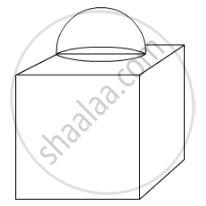Advertisements
Advertisements
प्रश्न
The largest cone is curved out from one face of solid cube of side 21 cm. Find the volume of the remaining solid.
उत्तर
The radius of the largest possible cone is carved out of a solid cube is equal to the half of the side of the cube.
Also, the height of the cone is equal to the side of the cube.
Radius of the cone = \[\frac{21}{2} = 10 . 5\]
Volume of the remaining solid = Volume of cube − Volume of cone
\[= \left( \text { Side } \right)^3 - \frac{1}{3}\pi r^2 h\]
\[ = \left( 21 \right)^3 - \frac{1}{3} \times \frac{22}{7} \times \left( 10 . 5 \right)^2 \times 21\]
\[ = 9261 - 2425 . 5\]
\[ = 6835 . 5 {cm}^3\]
Disclaimer: The answer given in the book is not correct.
APPEARS IN
संबंधित प्रश्न
If the total surface area of a solid hemisphere is 462 cm2 , find its volume.[Take π=22/7]
The largest possible sphere is carved out of a wooden solid cube of side 7 em. Find the volume of the wood left. (Use\[\pi = \frac{22}{7}\]).
150 spherical marbles, each of diameter 1.4 cm, are dropped in a cylindrical vessel of diameter 7 cm containing some water, which are completely immersed in water. Find the rise in the level of water in the vessel.
In Fig. 5, is a decorative block, made up two solids – a cube and a hemisphere. The base of the block is a cube of side 6 cm and the hemisphere fixed on the top has diameter of 3.5 cm. Find the total surface area of the bock `(Use pi=22/7)`

A right circular cone of radius 3 cm, has a curved surface area of 47.1 cm2. Find the volume of the cone. (use π 3.14).
2 cubes each of volume 64 cm3 are joined end to end. Find the surface area of the resulting cuboid.
A frustum of a right circular cone has a diameter of base 20 cm, of top 12 cm, and height 3 cm. Find the area of its whole surface and volume.
If the radii of circular ends of a bucket 24cm high are 5cm and 15cm. find surface area of
bucket?
Find the number of metallic circular discs with 1.5 cm base diameter and of height 0.2 cm to be melted to form a right circular cylinder of height 10 cm and diameter 4.5 cm .
Five identical cubes, each of edge 5 cm, are placed adjacent to each other. Find the volume of the resulting cuboid.
